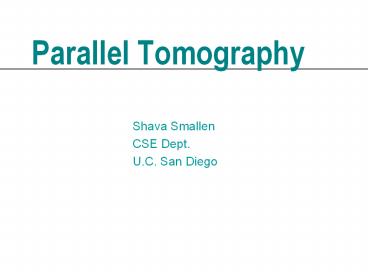Parallel Tomography - PowerPoint PPT Presentation
1 / 24
Title:
Parallel Tomography
Description:
Goal of project: Achieve performance using AppLeS scheduling and Globus services ... Shava Smallen, Jim Hayes, Fran Berman, Rich Wolski, Walfredo Cirne (AppLeS) ... – PowerPoint PPT presentation
Number of Views:84
Avg rating:3.0/5.0
Title: Parallel Tomography
1
Parallel Tomography
- Shava Smallen
- CSE Dept.
- U.C. San Diego
2
Parallel Tomography
- Tomography reconstruction of 3D image from 2D
projections - Used for electron microscopy at National Center
for Microscopy and Imaging Research (NCMIR) - Coarse-grain, embarrassingly parallel application
- Goal of project Achieve performance using
AppLeS scheduling and Globus services
3
Parallel Tomography Structure
Off-line
Solid lines data flow dashed lines control
4
Parallel Tomography Structure
On-line
preprocessor
Solid lines data flow dashed lines control
5
Parallel Tomography Structure
- driver directs communication among processes,
controls work queue - preprocessor serially formats raw data from
microscope for parallel processing - reader reads preprocessed data and passes it to
a ptomo process - ptomo performs tomography processing
- writer writes processed data to destination
(i.e. visualization device, tape)
6
NCMIR Environment
- Platform collection of heterogeneous resources
- workstations (e.g. sgi, sun)
- NPACI supercomputer time
- (e.g. SP-2, T3E)
- How can users achieve execution performance in
heterogeneous, multi-user environments?
7
Performance and Scheduling
- Users want to achieve minimum turnaround time in
the following scenarios - off-line already collected data set
- on-line data streamed from electron microscope
- Goal of our project is to develop adaptive
scheduling strategies which promote both
performance and flexibility for tomography in
multi-user Globus environments
8
Adaptive Scheduling strategy
- Develop schedule which adapts to deliverable
resource performance at execution time - Application scheduler will dynamically
- select sets of resources based on user-defined
performance measure - plan possible schedules for each set of feasible
resources - predict the performance for each schedule
- implement best predicted schedule on selected
infrastructure
9
AppLeS Application-Level Scheduling
- Each AppLeS is an adaptive application scheduler
- AppLeSapplication self-scheduling application
- scheduling decisions based on
- dynamic information (i.e. resource load
forecasts) - static application and system information
10
Resource Selection
- available resources
- workstations
- run immediately
- execution may be slow due to load
- supercomputers
- may have to wait in a queue
- execution fast on dedicated nodes
- We want to schedule using both types of resources
together for an improved execution performance
11
Allocation Strategy
- We have developed a strategy which simultaneously
schedules on both - workstations
- immediately available supercomputer nodes
- avoid wait time in the batch queue
- information is exported by batch scheduler
- Overall, this strategy performs better than
running on either type of resource alone
12
Preliminary Globus/AppLeS Tomography Experiments
- Resources
- 6 workstations available at Parallel Computation
Laboratory (PCL) at UCSD - immediately available nodes on SDSC SP-2 (128
nodes) - Maui scheduler exports the number of immediately
available nodes - e.g. 5 nodes available for the next 30 mins
- 10 nodes available for the next 10 mins
- Globus installed everywhere
13
Allocation Strategies compared
- 4 strategies compared
- SP2Immed/WS workstations and immediately
available SP-2 nodes - WS workstations only
- SP2Immed immediately available SP-2 nodes only
- SP2Queue(n) traditional batch queue submit using
n nodes - experiments performed in production environment
- ran experiments in sets, each set contains all
strategies - e.g. SP2Immed, SP2Immed/WS, WS, SP2Queue(8)
- within a set, experiments ran back-to-back
14
Results (8 nodes on SP-2)
15
Results (8 nodes on SP-2)
16
Results (16 nodes on SP-2)
17
Results (16 nodes on SP-2)
18
Results (32 nodes on SP-2)
19
Results (32 nodes on SP-2)
20
Targeting Globus
- AppLeS uses Globus services
- GRAM, GSI, RSL
- process startup on workstations and batch queue
systems - remote process control
- Nexus
- interprocess communication
- multi-threaded
- callback functions for fault tolerance
21
Experiences with Globus
- What we would like to see improved
- free node information in MDS (e.g. time
availability, frequency) - steep learning curve to initial installation
- knowledge of underlying Globus infrastructure
- startup scripts
- more documentation
- more flexible configuration
22
Experiences with Globus
- What worked
- once installed, software works well
- responsiveness and willingness to help from
Globus team - mailing list
- web pages
23
Future work
- Develop contention model to address network
overloading which includes - network capacity information
- model of application communication requirements
- Expansion of allocation policy to include
additional resources - other Globus supercomputers, reserved resources
(GARA) - availability of resources
- NPACI Alpha project with NCMIR and Globus
24
AppLeS
- AppLeS/NCMIR/Globus Tomography Project
- Shava Smallen, Jim Hayes, Fran Berman, Rich
Wolski, Walfredo Cirne (AppLeS) - Mark Ellisman, Marty Hadida-Hassan, Jaime Frey
(NCMIR), - Carl Kesselman, Mei-Hui Su (Globus)
- AppLeS Home Page
- www-cse.ucsd.edu/groups/hpcl/apples
- ssmallen_at_cs.ucsd.edu































